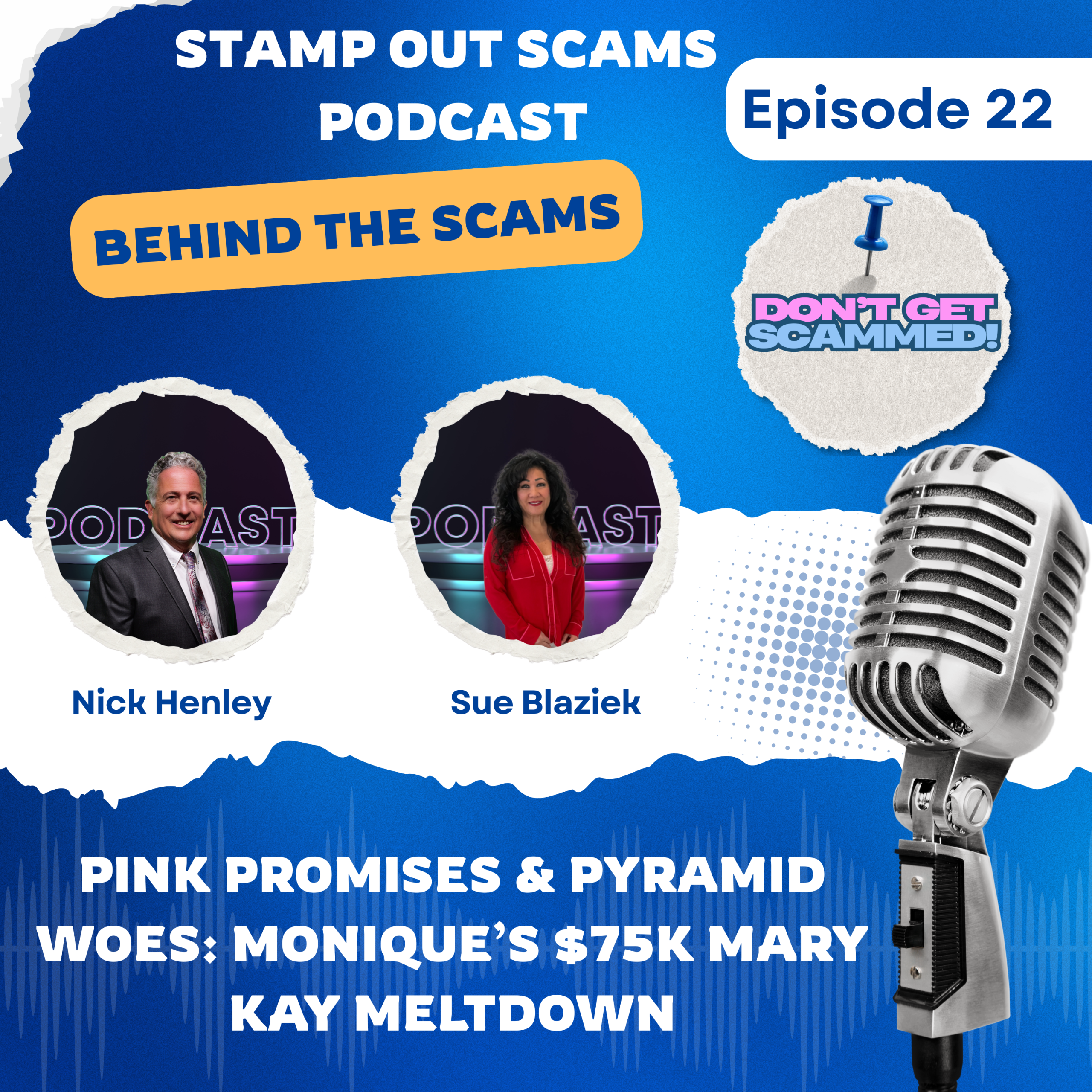Behind the Scams BlogCast: The Water Scam
Welcome to another BlogCast from Behind the Scams, where we transform our podcast episodes into written stories so you can read, listen, or do both. This case exposes how investors were lured into a fraudulent scheme involving bonds backed by vending machines that never even existed.
We’ve embedded the full podcast episode above so you can listen right here. The podcast is also available on all major podcast platforms, and you’ll find direct links listed just below the embedded player above, simply click to visit your preferred platform. You can also explore this episode, and all our other episodes, on our Behind the Scams podcast page.
Introduction
Picture this, let’s just say you get a pitch for the most boring-sounding investment ever—water vending machines. Fast forward, and you’re 50 million dollars lighter, holding collateral that exists only in PowerPoint, while the crook in charge is applying for a second mortgage on the same bag of chips machine you kind-of-sort-of own.
Welcome to the wild, waterless world of the Water Station Ponzi scheme. Pour yourself a glass (of anything but Water Station’s product) and dive in, as we break down the comedy, tragedy, and financial pipe dreams that rocked investors from Main Street to Wall Street.
A Mirage in the Desert: The Fool’s Gold of Water Vending Machine Investment Fraud
When it comes to water vending machine investment fraud, Ryan Ware and Water Station Management LLC didn’t just sell a dream—they sold a full-blown desert mirage. The pitch was irresistible: invest $8,500 per machine, and you’d own a piece of a “proprietary” water vending empire, raking in passive income while sipping umbrella drinks. As Ware himself promised,
‘Ware claimed that for an investment of eight thousand five hundred dollars per machine, you, the investor, would fund the manufacture of a water vending machine.’
Sounds like a solid deal, right? After all, who wouldn’t want to own a tangible asset that pays you while you sleep? Investors—especially military veterans seeking safe, steady income—lined up, checkbooks in hand. The company’s marketing was a masterclass in mixing technical jargon with the sweet music of “easy money.”
- 15,000 machines sold to investors
- Only about 6,000 real machines existed (and most weren’t even profitable)
- Over 250 defrauded investors from 2016 to 2024
But here’s where the oasis turns into a sand trap. Most of those water vending machines were as real as a mirage at high noon. In fact, thousands of machines were nothing more than lines on a PowerPoint slide—phantom assets sold and resold in a dizzying Ponzi scheme. Even the machines that did exist often sat idle, generating more dust than dollars.
Take Sue’s neighbor, for example—a retired veteran who thought her investment in Water Station would fund a Hawaiian vacation. Instead, she got a front-row seat to a bankruptcy proceeding. Turns out, the only thing flowing was her money… straight into the fraudster’s pocket.
So, was this marketing genius or scam artistry? Ware’s pitch blurred the line between a good business idea and a good old-fashioned con. He dazzled investors with talk of “joint ventures” and “proprietary technology,” making the passive income water machine investment sound as safe as bottled water. In reality, the only thing proprietary was the way he recycled investor funds to pay off earlier victims—a classic Ponzi scheme in a shiny, water-cooled wrapper.
For those caught in the current, the investor losses were very real, even if their machines were not. In the world of Water Station Management LLC, the only thing more abundant than water was wishful thinking.

Musical Chairs with Collateral: How One Snack Machine Had 25 Owners and a Bank Loan
When it comes to Ponzi schemes, Water Station Management LLC didn’t just play fast and loose with investor money—they turned fabricated collateral into an art form. In the world of water vending machines, things got so tangled that one humble machine ended up with more owners than a timeshare in Florida. And just when you thought it couldn’t get any more absurd, that same machine was also moonlighting as collateral for a bank loan. Talk about multitasking!
- One Machine, 25+ Owners: According to the records, “One particular water machine, for example, was assigned to at least twenty five separate joint venture investors. And get this, at the same time, he was using that very same machine as collateral in a bank loan application…” That’s right—one physical asset, dozens of investment contracts, and a bank officer all believing they had a claim. If only the machine could have collected rent from each owner!
- Snack Machines in Disguise: When the supply of actual water vending machines ran dry, Ware got creative. Sometimes, he’d assign a snack machine instead—because, really, who’s going to check if their “high-tech water dispenser” is actually full of chips and candy bars? It was a literal shell game, with fabricated serial numbers tossed in to keep everyone guessing.
- Phantom Machines and Fictitious Serials: Thousands of water vending machines were either nonexistent or had been sold multiple times. To keep the illusion alive, Ware invented serial numbers for machines that never existed. The result? A spreadsheet nightmare where even seasoned auditors were left scratching their heads, asking, “Wait… whose machine is this, exactly?”
It wasn’t just individual investors caught in the web. Institutional investors were issued Water Station notes, supposedly backed by these water machines. In reality, many of these notes were collateralized by assets that either didn’t exist or weren’t actually owned by the company. The fabricated collateral compounded the fraud, turning the investment contracts into little more than Monopoly money.
“One particular water machine, for example, was assigned to at least twenty five separate joint venture investors. And get this, at the same time, he was using that very same machine as collateral in a bank loan application…”
With double-selling, triple-selling, and the occasional snack machine masquerading as a water dispenser, Water Station Management LLC’s Ponzi scheme was less a business and more a high-stakes game of musical chairs—except when the music stopped, nobody knew who actually owned the chair… or if the chair even existed.

Passive Income? More like Passive Aggressive: The Mirage of Returns and Investor Fatigue
If you ever dreamed of a passive income investment so easy you could nap through it, the Water Station Ponzi scheme was here to sell you that dream—just with a side of investor fatigue and a dash of financial heartbreak. Ryan Ware’s operation promised effortless riches from water vending machines, but behind the scenes, it was more passive aggressive than passive income. Investors soon learned that in Ponzi schemes, the only thing flowing freely is disappointment.
Ware’s playbook was classic: pay early investors with money from new recruits, a textbook case of Ponzi-like payments. The illusion of profitability was maintained by robbing Peter to pay Paul, and occasionally buying himself something nice. As long as new money poured in, the house of cards stayed upright—at least for a while.
But what happens when investors start peeking behind the curtain? Enter the infamous “revenue portal,” a magical dashboard where investors could supposedly monitor their machine’s performance. Instead of seeing fountains of cash, they saw trickles, and not the refreshing kind. Complaints bubbled up as revenue numbers failed to match Ware’s hype. So, what did Ware do? He simply reassigned the same “high performing” water machines to multiple investors. If one machine was actually making money, he’d tell several people it was theirs. It was like musical chairs, but with vending machines—and everyone lost.
As scrutiny increased and investor losses mounted, Ware needed a new trick. In 2019, he switched many contracts from a percentage-of-revenue structure to a flat-fee payout. No more direct link between your machine’s supposed performance and your monthly payment. As one observer put it:
‘By moving to a flat fee, he removed the direct link between the machine’s supposed performance and the investor’s payment. This way, investors couldn’t easily see that their machines weren’t generating revenue…’
This desperate move made it harder for investors to spot the red flags. The flat fee was less about transparency and more about buying time—just enough to keep the Ponzi scheme spinning a little longer. Veterans and retail investors, many of whom trusted Ware’s pitch, were left holding the bag when Water Station bankruptcy hit in August 2024.
- Early investors got just enough “returns” to keep the illusion alive.
- Complaints skyrocketed as the numbers didn’t add up.
- Vulnerable investors Ponzi schemes—a cautionary tale in trust misplaced and returns never realized.

From PowerPoint to Portfolio: Bonds, Big Investors, and Bigger Lies ($275 Million Ponzi Scheme Details)
When the Water Station Ponzi engine started sputtering, it was time for a new playbook. Forget the small fish—Ware set his sights on institutional investors, rolling out a bond offering that was less “Wall Street” and more “Wizard of Oz.” The plan? Issue Class A and Class B bonds Water Station style, with a promise of collateral that, much like the plot, simply didn’t exist.
“The bond offering, which started around April twenty twenty two, was designed to raise substantial capital. Water station initially issued class a notes for fifty six point two five million dollars and class b notes for fifteen million. But through subsequent issuances, Ware ultimately managed to raise over one hundred million dollars in total from this bond offering. Over a hundred million dollars.”
Big Investors, Bigger Red Flags
Enter Jordan Chirico, a New York-based portfolio manager who apparently thought, “Why not invest my clients’ money in something as clear as mud?” Not only did Chirico’s fund scoop up millions in Class B notes, but he was also a joint venture investor in Water Station itself. That’s right—he was both the chef and the taste tester in this financial kitchen, a recipe for Jordan Chirico securities fraud and a masterclass in financial misconduct Jordan Chirico.
- Class A Notes: $56.25 million issued
- Class B Notes: $15 million issued (with Chirico’s fund as the primary buyer)
- Total Raised from Bonds: Over $100 million
- Total Ponzi Scheme: $275 million
Collateral: The Comedy of “Secured” Bonds
According to the prospectus, these investment contracts were “fully secured” by water machines and their revenue streams. The only problem? The machines were either imaginary, double-sold, or, in some cases, just repurposed snack machines. The bondholders were promised a special account where their payments would be deposited—based on revenue numbers that were pure fantasy. It was financial fiction at its finest.
Ware’s Personal Touch: The “Real” Guarantee
To make the whole charade seem legitimate, Ware even threw in a personal guarantee for up to $11 million. Because nothing says “trust me” like a personal IOU stapled to a pile of vaporware.
In the end, the Water Station bond saga was a masterclass in how to pitch institutional investors with nothing but a slick PowerPoint, a few fake machines, and a lot of wishful thinking. The only thing real? The collateral damage.

A Comedy of (Legal) Errors: Indictments, Bankruptcies, and the Societal Spillover
If you thought the Water Station Ponzi scheme was a masterclass in creative accounting, wait until you see the legal aftermath. When the music stopped and the last imaginary water machine was “assigned” for the 25th time, the real show began. Picture a courtroom packed with angry investors, exhausted regulators, and lawyers clutching binders thicker than the machines’ user manuals.
Southern District of New York Brings the Hammer Down
The Southern District of New York indictments hit like a tidal wave. Not to be outdone, the Washington DFI charges Water Station and the SEC all piled on, forming a regulatory conga line no fraudster wants to see at their door. As one official put it:
‘The Southern District of New York and Washington State Department of Financial Institutions brought parallel enforcement actions against Wear, Chirico, and related entities.’
The Water Station Ponzi scheme charges were no joke: wire fraud, securities fraud, and enough civil penalties to make even the most optimistic scammer sweat. The DOJ’s criminal charges could mean up to 20 years in federal housing—hardly the passive income the pitch deck promised.
Bankruptcy Water Station: The Creditor Circus Begins
By August 2024, Water Station was forced into bankruptcy, setting the stage for a creditor circus and investor heartbreak. Picture a game of musical chairs, but every chair is actually just a snack machine with a fake serial number. Investors lined up, hoping to recover their life savings, only to find out their “collateral” was as real as the company’s revenue reports (which, by the way, were inflated by a factor of fifty).
Societal Spillover: Investor Protection, Financial Fraud, and the Aftermath
As the dust settled, the societal spillover became painfully clear. Investor protection mechanisms failed spectacularly, tangled in a web of regulatory complexity and scam sophistication. The fraud, which ran from 2016 to 2024, left a trail of lost savings, endless legal battles, and a new urgency for reform.
- Parallel enforcement: DOJ, SEC, and Washington State DFI all on the case
- Potential 20-year sentences for the masterminds
- Bankruptcy proceedings that make a soap opera look straightforward
And one can’t help but wonder: What if regulators had shown up with a glass of real water, instead of PowerPoint slides? Maybe, just maybe, investors would have noticed the mirage before it evaporated.

The Faucet Drips Dry: Lessons, Laughs, and What We Should Actually Learn
As the last drops of the Water Station saga trickle out, it’s tempting to laugh at the absurdity—a Ponzi scheme built on phantom water machines, PowerPoint slides, and the world’s most disappointing snack vending collateral. But beneath the comedy lies a cautionary tale about investor protection financial fraud and the all-too-human optimism that keeps scam tactics in investment schemes alive and well.
Let’s be honest: scams don’t always show up in a villain’s cape. Sometimes, it’s just a guy with a charming pitch, a shiny brochure, and a water filter he probably bought on sale. The Water Station Ponzi scheme didn’t need a Hollywood villain—just a believable story and a promise of passive income. Retail investors and veterans, drawn in by the prospect of easy returns, found themselves holding the bag (and sometimes, literally, a bag of chips instead of a water machine). If you ever find yourself offered an ‘investment’ backed by a snack dispenser, remember: unless you’re very, very hungry, walk away.
Ponzi schemes thrive on confusion, false security, and the hope that this time, the mirage is real. The Water Station scam is a masterclass in how fraudulent investments nationwide can slip past even the most well-meaning investor. Complex contracts, dazzling returns, and “collateral” that’s more fiction than fact—these are the red flags that demand more than a second glance. Trust, but verify isn’t just a catchy phrase; it’s a survival skill in the wild world of investment schemes.
Financial fraud can be hilarious—until it happens to you. The laughter fades quickly when you realize your life savings have been poured into a bottomless well. That’s why education and advocacy for investor protection are more important than ever. Institutions and individuals alike need to wise up, ask tough questions, and demand transparency before the next waterless wonder comes along.
So, what should we actually learn? Vigilance and skepticism are the best investments you can make. If a deal is all sizzle and no steak—or, in this case, no water—walk away thirsty. The next time someone offers you a revolutionary opportunity with guaranteed returns, remember the Water Station: sometimes, the only thing flowing is the nonsense.
Federal Indictment
For those who want to see the case details firsthand, we’ve attached the official federal indictment that outlines the charges and evidence behind this scheme. It provides a clear look at how investigators unraveled the fraud and why the defendants now face serious consequences. Reviewing the indictment underscores the importance of transparency and due diligence in any investment opportunity. Knowledge is power—and in cases like this, it can be the best protection against becoming the next victim.


